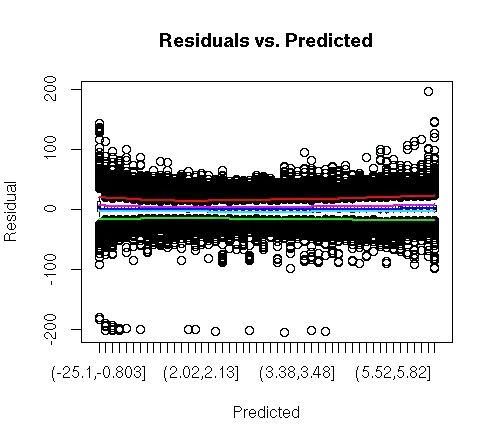Breusch-Pagan rejects the H0 on this residuals:
> length(model$residuals)
[1] 515959
> summary(model$residuals)
Min. 1st Qu. Median Mean 3rd Qu. Max.
-205.000 -4.420 -0.451 0.000 4.130 196.000
> quantile(model$residuals, seq(0, 1, 1/10))
0% 10% 20% 30% 40% 50% 60% 70% 80% 90% 100%
-205.228344 -10.137559 -5.705923 -3.400891 -1.814776 -0.450546 1.036849 2.914375 5.648389 10.733350 196.011350
> bptest(model)
studentized Breusch-Pagan test
data: model
BP = 1385.57, df = 14, p-value < 0.00000000000000022
Looking at the residuals variance with @whuber visualization function I don't see any heteroskedasticity issue:

So yes, there are some extreme observations at the tail of distribution, but is this enough to reject the H0?
Manual Breusch-Pagan test
summary(lm(I(model$residuals^2) ~ data$X1 + data$X2 + data$data$X3 + data$X4))
Call:
lm(formula = I(model$residuals^2) ~ data$X1 + data$X2 +
data$dataX3 + data$X4)
Residuals:
Min 1Q Median 3Q Max
-356 -100 -79 -23 41965
Coefficients:
Estimate Std. Error t value Pr(>|t|)
(Intercept) 176.52 4.82 36.66 < 0.0000000000000002 ***
data$X1 -5.21 0.28 -18.60 < 0.0000000000000002 ***
data$X2 -75.36 4.75 -15.88 < 0.0000000000000002 ***
data$X3 15.70 0.85 18.48 < 0.0000000000000002 ***
data$X4fact2 10.84 3.15 3.44 0.00059 ***
data$X4fact3 1.14 2.15 0.53 0.59735
data$X4fact4 96.31 6.98 13.80 < 0.0000000000000002 ***
data$X4fact5 191.39 12.73 15.04 < 0.0000000000000002 ***
data$X4fact6 3.44 4.03 0.85 0.39280
data$X4fact7 8.30 2.79 2.97 0.00298 **
data$X4fact8 19.38 2.66 7.29 0.00000000000031 ***
data$X4fact9 1.44 2.37 0.61 0.54468
data$X4fact10 46.35 11.19 4.14 0.00003435124602 ***
data$X4fact11 -6.23 2.71 -2.30 0.02168 *
data$X4fact12 18.07 3.46 5.22 0.00000017455269 ***
---
Signif. codes: 0 ‘***’ 0.001 ‘**’ 0.01 ‘*’ 0.05 ‘.’ 0.1 ‘ ’ 1
Residual standard error: 502 on 515944 degrees of freedom
Multiple R-squared: 0.00269, Adjusted R-squared: 0.00266
F-statistic: 99.2 on 14 and 515944 DF, p-value: <0.0000000000000002